April 28 - 29, 2003
at the birthplace of King Arthur, bilingual signs, dysfunctional train, and a surprise with excellent cuisine
| In the Land of the Red Dragon April 28 - 29, 2003 at the birthplace of King Arthur, bilingual signs, dysfunctional train, and a surprise with excellent cuisine |
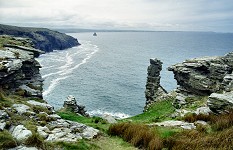 |
||
| We were somewhat uncertain whether these crumbling structures on the northern side of the (pseudo)island of Tintagel were rocks or very, very old walls. |
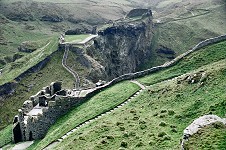 |
||
| The fortress on Tintagel was obviously impenetrable by medieval means. |
The Legend of King Arthur is one of Cornwall's great attractions. According to the story, King Uther Pendragon fell in love with Ygraine, wife of Cornish duke Gorlois. Merlin enchanted Uther to take duke's appearance and he thus equipped came to Tintagel, Gorlois's castle, where he met Ygraine and begot Arthur with her. The boy was right after birth given into Merlin's care, who kept the royal pretender until his teens hidden in France and in the court of Welsh duke Ector.
Tintagel is a special place - a huge rock in the sea, connected with the mainland only by a narrow rocky ridge. The rock was inhabited already by 5th century AD, and some Mediterranean ceramic shards were found that fall into the time of Arthur's legend, very rare on British isles. It would seem that Tintagel of that time was a seat of a rich and powerful ruler. Ruins of a castle, which you can see today, are of course much younger - they come from 13th century, when Earl Richard decided to enhance his reputation by creating stronger ties with Arthur's legacy, by building a fortress on this unstable rock. The structure started to fall apart even before it was finished -- stormy Atlantic Ocean and rainy, windy climate bite successfully through stone walls. The castle was never quite habitable (despite low medieval standards and usual lack of comfort); for every Richard's visit, the court had to move a complete set of facilities, including furniture and plants for castle garden.
 |
||
| Welsh flag |
Tintagel was our last Cornish attraction -- soon we were entering Wales. This region of United Kingdom is even more non-English than Cornwall. While in Cornwall you may find an occasional strange name and mentioning of the old Cornish language, Welsh names everywhere appear to have the only purpose: to twist your tongue. Sid's driving queries, "OK, on this intersection we can choose between Abergwesyn to Aberystwyth, or Llangammarch towards Llandrindod, which turn should I take?" simply drove me nuts.
S: All signs in Wales (or Cymru, which is the Welsh name of Wales) are either bilingual - English being the second language - or only Welsh. National symbol, present on the Welsh flag (red dragon, Y Ddraig Goch), unlike symbols of Scotland and Ireland (red and blue crosses) did not make it to British flag, so the Welsh people compensate by dragon's omnipresence, including on those little soaps and shampoo bottles you find at hotel rooms. Well, if I can judge by overhearing dialogues at pubs and grocery stores, both adults and kids talk to each other in English, albeit with an accent (which, of course, one may observe anywhere in Britain). This bilingualism seems to me rather a matter of spite; only local-looking people we ever noticed talking in a funny, archaic sounding, soft non-English, turned out to be political activists sporting stickers of Party of Wales (Plaid Cymru) on their cars, who, as one could assume, performed this as part of their political image.
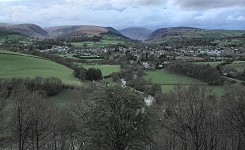 |
||
| Rhayader in central Wales. Hotel Brynafon can be found on the right edge of the picture |
The landscape of central Wales is very mild -- green hills, plenty of sheep, houses built of stone, small villages. It's interesting how easy it is to pick up some elevation and one finds complete wilderness - just wind, moor, sky, and no living soul around.
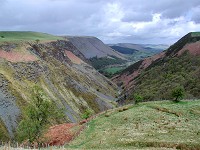 |
||
| Twymyn River Canyon near a forest with an unpronounceable name : Ffrwd Fawr. |
With evening approaching, we began to look for a place to sleep, when Sid turned suddenly toward a building behind a sign that said "Brynafon Country House". On a first glance, this stone house did not look inviting, its dark air underscored by large number of loud crows nesting in leafless crowns of trees surrounding the building, but we were treated with kindness and accommodated at a cozy little room there. And since we were tired of sitting the whole day in the car, we ran up the nearest hill before the sun could set, pondering whether Scotland would be also this romantic and whether we should stay in Wales instead.
S: Brynafon (our hotel) is a place of history. Having been built around 1878
as the Rhyader Workhouse and a vagrant ward. There is a story that vagrants
crushed local stone there, and then pushed it through measured iron window grids (glassless then, of course).
After they reached a certain quota, they got a free breakfast. But some of them figured that breakfast
was served first and then vanished, without breaking the stone. Thus a rule was made that breakfast was
served only after they met they quota. For some reason, this very logical idea was posted inside the hotel
lobby with an exclamation point.
The house later found its use as a School for the Deaf, war time evacuee house, a factory,
a local fire drill site... Since 1989, you can find here a comfortable and relatively affordable
accommodation.
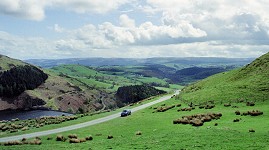 |
||
| Clywedog Reservoir in central Cambria Actually our only picture featuring our blue rental car. |
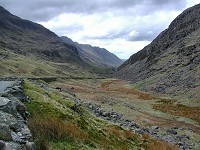 |
||
| Nantgwygnant Valley Landscape around Snowdon is indeed breathtaking. Snowdon itself sat in a cloud, though. |
Yet in the morning Sid said that he'd like to take a train up to Snowdon, so we packed and continued our ride. We delved into the land of Cambrian Mountains full of hills, natural and man-made lakes, sheep and moors, enjoying it especially after my usually well-oriented husband decided to take a turn into a "shortcut" around Clywedog Reservoir, which later turned out to be quite different from the road he followed on a map. For the following hour we jumped over cattle grids and, while trailing yet another SUV driven by a vacationing geezer, prayed that the single lane road widens again so we would not have to go 20 mph. Views to the land were worth it, though.
Unfortunately for us, Snowdonia presented itself as much less friendly than the rest of Wales.
Its touristy industrialism reminded me of our experiences of
summer of 2001,
at Obertraun in Switzerland. Miss at the register admitted to the train to Snowdon truly going there sometimes,
but refused to sell us tickets for the next day claiming that they did not know when and if they would go
at all; today they went only to the mid-slope (full price, of course), and anyway her shift was over.
Also, we could not find accommodation anywhere in vicinity -- the only hotel without a "no vacancy"
sign sported another sing on a door saying "I'll be back at 5 o'clock". At five fifteen, there were
several of us gathered, all customers desiring rooms, but doors stayed locked and the sign still said five.
Given the fact that it did not say which DAY at five, we chose to remove Snowdonia altogether from our plans,
and zoomed eastwards, disappointed.
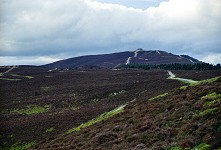 |
||
| Moel Fammau Our ascent to the viewpoint was rather easy, though (naturally) uphill, so it took much of our huffing and puffing. |
Having expected that it would be easier to spot a vacant hotel outside of tourist crowds, we were wrong -- a less interesting part of Wales east of Snowdon did not offer hotels at all and approaching industrial zone around Liverpool did not make it better. So we stopped before the last range, in Ruthin. Ye Olde Anchor Inn was a lucky hit. Our greatest surprise was finding the local cuisine EXCEPTIONALLY GOOD, breaking the rule of your usual English food fare. Cooked by Master Chef, everything was perfect, precisely spiced, smelling wonderfully and tasting even better.
Which means I am getting ahead of myself a bit here -- before dinner, we longed to stretch our feet somewhere and we traditionally headed to the nearest high hill on a horizon. Our intuition was right again. At the summit of the road, we found a parking and a network of hiking trails. The parking lot required a fee to be paid at a ticket machine, but it did not say what to do if you don't have exact change - we figured for once they would have to do without our contribution, and strode off.
On our way up we argued constantly -- I claimed that if we go all the way to a strange ruin on the highest hill, we would miss dinner, while Sid kept assuring me that he had it all estimated and that we would manage. The strange building turned out to be a base of a former tower, turned into a viewing platform. We got there just to see the sunset and after getting back to our car (no boot nor parking ticket), we took a shortcut over a narrow road with a warning sign "not suitable for motor vehicles". Sure, we had to pass through a herd of impassive sheep, but there was quite heavy car traffic going on there -- we inferred that "locals must know better" and even beat our hotel arrival estimate -- and got there soon enough for dinner. Our server was delighted to hear our praising of such a pretty mountain near the town, but she could not quite believe that we managed to hike there between reserving our room (around six o'clock) and dinner (at eight thirty). Perhaps a journey to Moel Fammau represents a whole day affair for the locals...
| Copyright © 2003-2005 by Carol & Sid Paral. All rights reserved. |